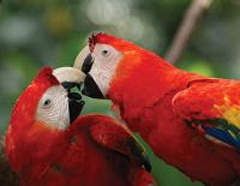
|  |  |  Editorials | Environmental Editorials | Environmental  
Guatemalan Wildlife at the Mercy of Traffickers
 Danilo Valladares - Tierramérica Danilo Valladares - Tierramérica
go to original
May 17, 2010


| | The scarlet macaw is one of many species needing protection from traffickers. (CONAP) |  |
Guatemala City - The shortage of resources for law enforcement and high demand from the wealthy countries of the North have left the field wide open in Guatemala for trafficking of wild animals, many of which are endangered, warn experts and environmentalists.

The region of Guatemala most affected by species trafficking is the northern province of Petén, bordering Mexico, where the government declared a 2.1-million-hectare site a protected area in a bid to optimise conservation and restore devastated flora and fauna.

Petén has an area of 35,854 square kilometres and is home to one of the largest tropical forests in the Americas, in addition to numerous archaeological sites of the indigenous Maya culture.

Although there are control systems in place there, Julio Madrid, delegate from the National Council of Protected Areas (CONAP) in Petén, acknowledged that it is a difficult task because there are just 300 rangers for the entire forest.

The smuggling of animals from the area has become a common activity. "There is a technical unit for control and protection that is in charge of the animals confiscated (from the traffickers), which are then taken to a rescue centre," Madrid told Tierramérica.

That was the fate, for example, of the animals discovered when they were brought into the United States in December 2009. The shipment, addressed to Bruce Edelman Reptiles Imports and Exports, Inc. in Miami, triggered doubts by the U.S. Fish and Wildlife Service, which then alerted Guatemalan officials.

The shipment included 300 green iguanas and an indeterminate number of turtles, frogs and tarantula spiders - all threatened species.

The alert from the U.S. led CONAP to discover that the company Zooservicios, which sent the shipment, had authorisation only to trade in iguanas.

Although the iguanas also are at risk of extinction, the ones confiscated in Miami were hatched in captivity and could therefore be sold legally, CONAP wildlife director Kurt Dutches explained to Tierramérica.

"There are companies in this country dedicated to reproducing white-tailed deer, frogs, iguanas and other animals, which can be exported under regulation and prior compliance with the law," which establishes authorisation only "for those animals produced in captivity" at least second generation, he said.

The confirmation of the illegality of the other animals led to the cancellation in March of Zooservicios's operating permit.

It wasn't the first time that the firm had used such a ruse to sell wildlife.

Between November 2008 and April 2009, Zooservicios had sent 5,112 animals to Miami, all illegally, according to a CONAP investigation, which led to a federal lawsuit filed Jan. 11.

Another case of contraband came to light Mar. 12, when police found a home in Guatemala City with more than 70 wild animals, including macaws, deer, peacocks, pheasants, raccoons, parrots, parakeets, toucans and capuchin monkeys.

CONAP reports that Guatemala has 1,600 species of flora and 740 species of fauna in danger of extinction.

The environmental protection law enacted in 1996, which created CONAP, establishes a prison term of five to 10 years and a fine of 1,250 to 2,500 dollars for the crime of trafficking in endangered species.

According to the authorities, there is a long list of animals in great demand abroad, especially in the United States and Europe, where they are sold as exotic pets.

Among them are the green iguana (Iguana iguana), desert iguana (Dipsosaurus dorsalis), red-eyed tree frog (Agalychnis callidryas), green-eyed frog (Lithobates vibicarius), as well as snakes, tarantulas and turtles.

Veterinarian Fernando Martínez, of the non-governmental Wildlife Rescue and Conservation Society and the Wildlife Rescue Centre, told Tierramérica that 300 to 500 animals go through the rescue centre each year, most of which come from illegal trade.

"We have seen that there is less animal trafficking each year," said the expert. However, he was quick to point out that it isn't the result of better enforcement, but rather "the loss of natural habitat in the reserve, because every year the farm frontier expands," and with it, there is greater deforestation.

For Martínez, the lack of resources is a serious impediment to protecting biodiversity, and, in his opinion, the government is not concerned enough about the situation.

Beyond the illegal trade in wildlife, Julio González, of the non-governmental MadreSelva Environmental Collective, said in comments to Tierramérica that the changes in land use, the expansion of monoculture farming, hydroelectric dams and mining are important factors behind the great loss of biodiversity.

He is calling for reforming the Law on Protected Areas and the Forestry Law of 1996 in order to safeguard the environment - and by association, the lives of human beings.

This story was originally published by Latin American newspapers that are part of the Tierramérica network. Tierramérica is a specialised news service produced by IPS with the backing of the United Nations Development Programme, United Nations Environment Programme and the World Bank. |

 |
|  |



